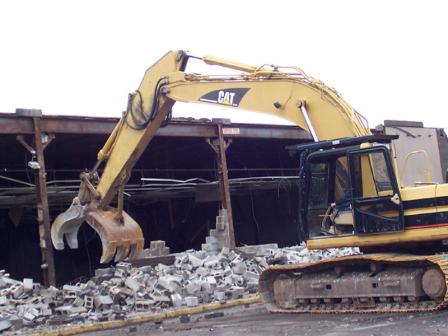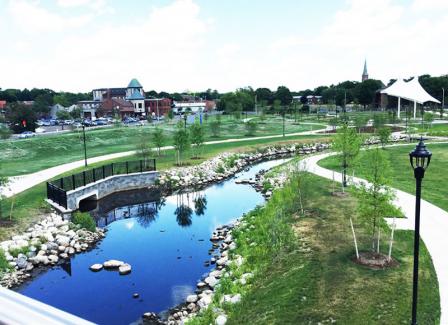News Releases from Region 01
EPA Provides Brownfields Grants and Assistance to Connecticut Communities
Brownfield Funding and Work Leverages Jobs and Promotes Economic Redevelopment
BOSTON - Today, the U.S. Environmental Protection Agency (EPA) announced that Hartford, Shelton, and Waterbury Conn. are among 172 communities across the country to receive funding and/or EPA technical assistance for brownfield site revitalization efforts. The City of Shelton was awarded an EPA Brownfields assessment grant of $200,000, and the City of Hartford was selected to receive a technical assistance grant worth $130,000 and the Waterbury Development Corp. was selected to receive EPA technical assistance worth $120,000.
Nationwide, a total of approximately $56.8 million has been awarded by EPA to fund selected recipients for brownfield site assessments and clean up, as initial steps towards redeveloping vacant and unused properties; transforming them to productive reuse which will benefit the community and the local economy.
EPA's Brownfields grants and assistance to Connecticut this year are among another significant annual investment by EPA to help New England communities address brownfield properties. Across the six New England states this year, EPA is awarding a total of $10.4 million for 32 communities to undertake work assessing or cleaning brownfields. EPA has also awarded an additional six communities technical assistance for brownfield work, valued at $750,000. A brownfield is a property for which the expansion, redevelopment, or reuse may be complicated by the presence or potential presence of a hazardous substance, pollutant, or contaminant. There are estimated to be more than 450,000 brownfields in the U.S. Cleaning up and reinvesting in these properties increases local tax bases, facilitates job growth, utilizes existing infrastructure, takes development pressures off of undeveloped, open land, and both improves and protects the environment.
"EPA is committed to working with communities to redevelop Brownfields sites which have plagued their neighborhoods. EPA's Assessment and Cleanup grants target communities that are economically disadvantaged and include places where environmental cleanup and new jobs are most needed," said EPA Administrator Scott Pruitt. "These grants leverage considerable infrastructure and other investments, improving local economies and creating an environment where jobs can grow. I am very pleased the President's budget recognizes the importance of these grants by providing continued funding for this important program."
In New England, since the beginning of the Brownfields program, EPA has awarded 382 assessment grants totaling $103.9 million, 73 revolving loan fund grants and supplemental funding totaling $90 million and 290 cleanup grants totaling $69.9 million. These grant funds have paved the way for more than $2.4 billion in public and private cleanup and redevelopment investment and for nearly 15,499 jobs in assessment, cleanup, construction and redevelopment.
Nationwide, approximately $17.5 million of the assessment and cleanup funding announced today will benefit small and rural communities with populations less than 10,000. Approximately $25 million will go to communities who are receiving assessment and cleanup funding for the first time. Selected recipients will each receive approximately $200,000 - $600,000 in funding to work on individual sites or several sites within their community. These funds will provide communities with resources necessary to determine the extent of site contamination, remove environmental uncertainties and clean up contaminated properties where needed. Brownfields assessment and cleanup activities are strides closer to realizing a sites' full potential, while protecting public health and the environment.
For example, decline of industrial and commercial activity in Meriden, CT, followed by the construction of an indoor mall over a brook that caused $26million dollars in flood damages, was causing a negative impact on the community. The City of Meriden acquired brownfields properties in the area known as the HUB site, and received both federal and state funding for cleanup and redevelopment work. After charrettes and workshops and widespread community involvement, the community agreed on a common vision for the redevelopment of the HUB Site, now called the Meriden Green. It includes access to open space and other public amenities such as a farmer's market, a public park and links to a regional greenway system.
Addressing and cleaning up sites, like those in the Meriden neighborhood, across the nation will ultimately boost local economies and leverage redevelopment jobs while protecting public health and the environment. Brownfield sites are community assets because of their locations and associated infrastructure advantages. Studies have shown that residential property values near brownfields sites that are cleaned up increased between 5 and 15.2%. The study also determined that brownfield cleanup can increase overall property values within a one-mile radius. A study analyzing data near 48 brownfield sites shows that an estimated $29 to $97 million in additional tax revenue was generated for local governments in a single year after cleanup. This is 2 to 7 times more than the $12.4 million the EPA contributed to the cleanup of those brownfields.
There are an estimated 450,000 abandoned and contaminated waste sites in America. As of May 2017, more than 124,759 jobs and $24 billion of public and private funding has been leveraged as a result of assessment grants and other EPA Brownfields grants. On average, $16.11 was leveraged for each EPA Brownfields dollar and 8.5 jobs leveraged per $100,000 of EPA brownfields funds expended on assessment, cleanup, and revolving loan fund cooperative agreements.
More information:
- List of the FY 2017 Applicants Selected for Funding (www.epa.gov/brownfields/brownfields-list-fy17-grants-selected-funding)
- EPA's brownfields program (www.epa.gov/brownfields)
- EPA's work on brownfields in New England (www.epa.gov/brownfields/brownfields-and-land-revitalization-connecticut-maine-massachusetts-new-hampshire-rhode)
- More on successful Brownfields stories (www.epa.gov/brownfields/brownfields-success-stories)


